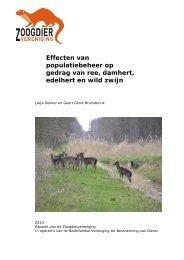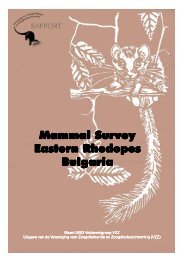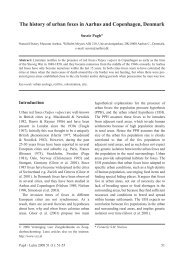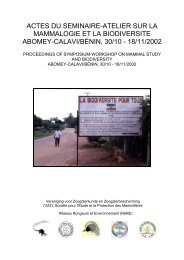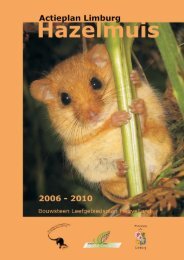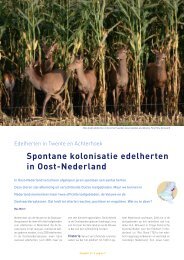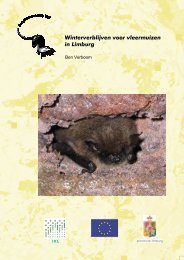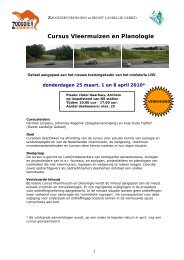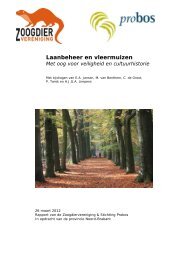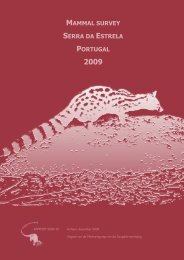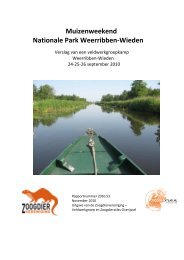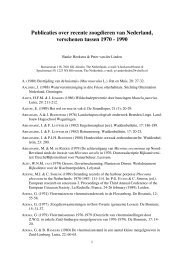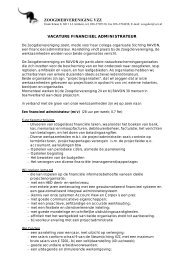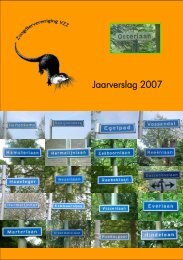Mammal survey Pol'ana - De Zoogdiervereniging
Mammal survey Pol'ana - De Zoogdiervereniging
Mammal survey Pol'ana - De Zoogdiervereniging
Create successful ePaper yourself
Turn your PDF publications into a flip-book with our unique Google optimized e-Paper software.
2 LANDSCAPE by: Janny Resoort<br />
2.1 SLOVAKIA<br />
Slovakia has an area of 49.033 km 2 (1.2 × the<br />
Netherlands) on which 5.4 million inhabitants live.<br />
With an area of 1.9 million hectares of forest (38%<br />
of the entire country) Slovakia is one of the woodiest<br />
countries in Europe. Of that area, 1.5 million ha is<br />
exploited. In the woods bears are living as well as<br />
wolves, lynxes, wild cats and deer.<br />
Slovakia has ranged itself into the economic<br />
forefront of Central Europe. However, a dichotomy<br />
has developed between city and countryside: the rich<br />
city with its (primarily automobile-) industry and the<br />
poor countryside that is abandoned by anyone who<br />
wants to go to college. This has caused an<br />
enormous social, cultural and political gap in the<br />
country.<br />
Diverse landscape types around Látky.<br />
Slovakia has joined the European Union on May 1 st , 2004 and since then new impulses have been given to<br />
the countryside, especially to the sector of tourism (networks of walking- and cycling tracks and skiing areas).<br />
Unfortunately the expanding tourism and the exploitation of hunting-grounds, which attract many West<br />
European hunters, cause a threat to the valuable ecosystem. Because of industrialization and air pollution<br />
(acid rain) many trees, plant- and animal species are threatened or even became extinct in the last decades.<br />
Physical Physical geography<br />
geography<br />
The landscape of Slovakia that coincides with the Carpathian Arc, shows a very complicated structure. Just like the<br />
Alps, the Carpathians form a complex landscape that is called in Dutch “dekbladenlandschap”, but the articulation is<br />
totally different. As a result of continuous rupture movements of the earth crust, the original (chain of) Carpathian<br />
mountains is fragmented into a large number of small mountains with basin landscapes in between. In the Western<br />
Carpathians, between the Danube at Bratislava and the Dukla pass, a double series of small massives occurs, the<br />
center of which consists of granite and crystalline slate, which are mutually connected by Permian- and Chalk layers.<br />
These “cores” form the highest parts of the mountainous area, mostly in the High and Low Tatra. Another part of the<br />
Western Carpathians however consists of strongly folded Mesozoic sedimentary rock. South of this area are the<br />
Slovakian Ore Mountains, which have a crystalline composition. To the east of it, only separated by the Eastern<br />
Slovakian lowland, is the Hergyalla-chain existing of volcanic rock. The Western Slovakian lowland is separated by<br />
the Small Carpathians, consisting of granite.<br />
Source: http://www.worldwidebase.com/science/slowakije.shtml<br />
<strong>Mammal</strong> <strong>survey</strong> <strong>Pol'ana</strong> (Slovakia) 2005 11<br />
Photo: Jan Buys



